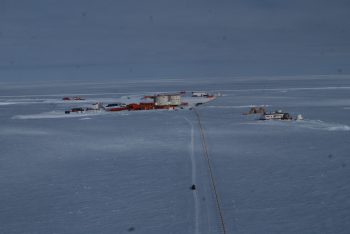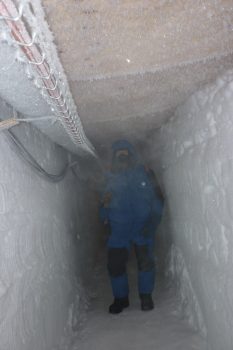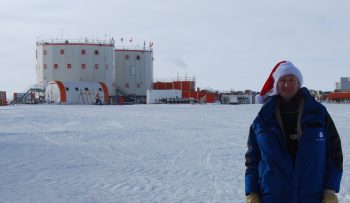Didier Schmitt is a member of the space Task Force at the European External Action Service. He is a regular opinion writer in major newspapers and magazines and has published a book on foresight. He will be contributing to this blog during his visit to Concordia – we join him at Concordia after an 11-day ‘Raid’ supply trek in a tractor-caravan:
The Raid does not finish once it is onsite. We need to dispatching the newly arrived containers and retrieve other ones that are mainly stuffed with waste. I said goodbye in the early morning to my friends who will now ride “downhill” for nine days if the trip back to the coast goes as smoothly as it did on the outward trip. A special moment that felt like I was giving up on them. But I had an irresistible opportunity to stay and visit the Concordia base, so my tractor was put on sledges and carried back to save fuel.
My first and most impressive visit was by chance. I met the head scientist for seismology and asked him about a possible visit of his mysterious cave I had heard of. His answer was “you can go in 5 minutes or never”. The location can only be disturbed when there is maintenance work being done which is only every few years! I put on every layer I had in my bags and after a 700 m walk we went into a first cave opening. We crossed a 100 m tunnel, then down through two other buffer zones via ladders. Like in a pyramid, we ended up in a 4×4 m chamber. We found ourselves at –12 m and at –55°C! It was a very impressive moment.
The main objective of the seismology programme at Concordia is the continuous observation of ground motion. It is one of the only two permanent seismological stations on the Antarctic continent. The location and the international seismological community is eager to get unique data in real time from here.
Next I visited the ice-core storage from the EPICA programme. The programme resulted in 3200 m of ice cores with a quarter of them staying here 10 m below surface. It is obviously the safest place on Earth to store ice, no energy is needed for cooling as the area is typically a cool –50°C naturally!. The most stunning results – a world record – are the climate cycles that can be observed over 800 000 years. Our current greenhouse gas emissions are over any of the emissions measured in that entire period!
Just next to the EPICA site, another record-setter is in preparation: Subglacior will revolutionise ice coring using a new laser technique. It is partly funded by the European Research Council. Together with more traditional hardware the objective for next year is to retrieve ice from up to 1.5 million years old.
Scientists from over 10 countries have already participated in research programmes at Concordia. The Antarctic ice sheet acts as a thermostat to stabilise Earth’s climate. If it were to melt (and it is showing accelerated melting already) the sea level would rise by 60 m, changing all continental landscapes!
See also the TAAF blog: https://terreadelie-antarctique.blogspot.fr







Discussion: one comment
I wish I could visit Concordia some day.